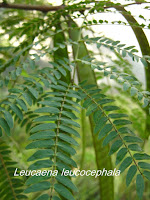Leucaena leucocephala (Lam.) De wit is a tropical species of small tree native to South America. It is known as petai belalang in Malay language. In Indonesia, it is known as lamtoro.
The specific name is derived from Greek word λευκό which means “white” ; and κέφαλος which means “head”, in allusion to its flowers.
Symnonyms : Acacia leucocephala (Lamark) Link 1822, Leucaena glabrata Rose 1897, Leucaena glauca (L.) Benth 1842, Mimosa leucocephala Lamark 1783
There are 3 subspecies : subsp. leucocephala, subsp. glabrata, and subsp. ixtahuacana.
L. leucocephala can grow up to 20 meter in height.
The leaves are bipinnate. Leaflets are 9-16mm long and 2-4mm wide.
Flowers are actinomorphic, about 12-21mm diameter, cream white colour, 10 free stamens per flower, hairy anthers.
Pod occure in cluster of 5-20 per flower head, 11-19cm long, 15-21mm wide, flattened, 8-18 seeds per pod, dehiscent.
Pollination via insects, self-fertile.
Trees are generally short-lived ( 20-40 years )
It can grow in wide range of habitats : coastal, riverine, semi-natural, ex-mining, disturbed sites etc
L. leucocephala is susceptible to the psyllid Heteropsylla cubana, which cause serios defoliation and mortality.
Ganoderma lucidum causes root rot.
L. leucocephala is efficient in nitrogen fixation, at more than 500kg/ha/year.
The leaves are highly nutritious for ruminants.
 The wood is used as firewood, and produced into charcoal. It can also be used for parquet flooring, furniture, as well as paper pulp. Straight trunk is used as posts.
The wood is used as firewood, and produced into charcoal. It can also be used for parquet flooring, furniture, as well as paper pulp. Straight trunk is used as posts.
L. leucocephala thickets are used as windbreeakers and firebreakers.
The young seeds and young leaves are consumed as vegetables.
In Indonesia, ‘tempe lamtoro’ is made of fermented leucaena seeds.
The leaves and seeds contain mimosine, a toxic to non-ruminant vertebrates, thus not advisable to consume in large quantity.
Mimosine is broken down in the rumen to DHP ( 3-hydroxy-4-(1H)-pyridone ), which is further broken down by rumen microorganisms to non-toxic compounds.
Reference




No comments:
Post a Comment